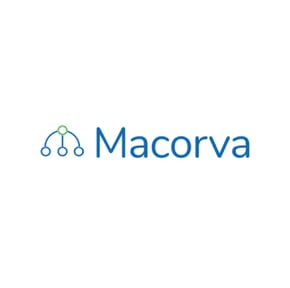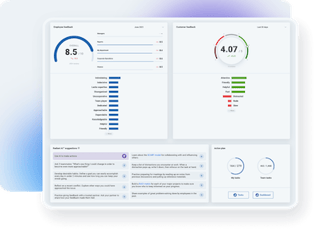
Employee Wellness Survey Guide: 9 Essential Factors for a Healthier Hybrid Workforce
In the post-pandemic economy, employee wellness has evolved from a buzzword to a strategic necessity. Gallup surveys indicate that 27% of the workforce is exclusively remote, while over half use a hybrid model that splits on-site and remote duties. While this shift offers flexibility, it also introduces unique challenges that can heighten worker stress, fatigue, burnout, and depression. To combat these issues, leaders need a clear view into their employees' experiences. Implementing regular employee wellness surveys creates a continuous feedback loop, delivering the actionable insights needed to protect employee well-being and prevent losses in productivity and engagement.
This guide to employee wellness surveys provides practical strategies for addressing the core challenges of hybrid work, from digital well-being to work-life balance.
The insights you gather are essential for guiding your workforce wellness investments, helping you move beyond guesswork to build a healthier, more productive, and resilient team.
To maximize your survey's impact, start by focusing on these nine critical elements.
1. Stress and Burnout
Stress negatively affects every system in the human body. High stress levels have been linked to chronic health issues, including high blood pressure and sugar, heart disease, and immune deficiencies. Because its effects are both severe and pervasive, particularly in context with other lifestyle factors, it is important to include questions around stress in your wellness survey.
According to the World Health Organization’s workplace stress statistics for 2025, 12 billion workdays are collectively lost every year due to anxiety and depression. The productivity loss has been estimated at $1 trillion per year, otherwise known as the “burnout cost.” This indicates an increasing level of pressure to perform and respond in digital workspaces even outside of work hours. This takes a toll on workforce stress levels and turnover rates. According to Fortune, 1 in 5 employees is so stressed that they think of quitting their current job every day of the week. These are worrying numbers, with effects that contribute to employee exhaustion, burnout, and turnover, often leading to medical costs, absenteeism, and more turnover.
These are worrying numbers, with effects that contribute to employee exhaustion, burnout, and turnover in conjunction with the previously mentioned physical conditions, which often lead to medical costs, absenteeism, and more turnover. The StressPulse Report also found 42% of workers lose around a half hour per day due to stress. Over half of workers (54%) miss 1-2 days per year because of stress while around 1 in 7 workers miss at least an entire week.
Yet, despite these harrowing figures, only 25% of employers offer stress management programs, and only 18% offer meditation or mindfulness. According to another study conducted by the APA, only 21% of employees report having any meeting-free workdays, and only 15% report mental health days at work.
All these statistics have a common conclusion: that stress is dangerous for the health and productivity of workers, yet it is not a priority for most business leaders. Hybrid workplace wellness in the modern workforce demands friction-free, asynchronous feedback channels that include accurate employee wellness survey tools and intentional wellness programming. This begins with accurate survey questions that address the causes of employee stress, such as:
☐ I am able to manage work-related stress.
☐ I feel emotionally stable at work.
☐ I experience normal levels of stress at work.
☐ I am comfortable with my work/life balance.
☐ I have access to resources that reduce stress.
☐ I would recommend this job to someone susceptible to workplace stress.
☐ I am happy with my workload and performance expectations.
☐ I feel that management cares about my stress levels.
☐ I feel that I can balance my work and home life.
*1-5 scale from Strongly Disagree to Strongly Agree
Learning the causes of employee stress levels, especially in new hybrid workflows, helps organizations improve stress management and well-being initiatives while lowering the burnout cost. However, offering assessments, stress management workshops, meditation sessions, and on-demand counseling services is just the start of refined wellness protocols in modern hybrid environments. The work environment and management attitude must change to reflect the new work-life models.

2. Work Environment
Employee productivity relies in large part on a comfortable work environment. This has only become more important in the post-pandemic economy, where remote work opportunities are plentiful. Surveys have found that employees switching to remote work tend to have higher engagement but lower well-being owing to high stress and isolation. Individuals with chaotic homes may be particularly susceptible to being burnt out, not just by their work, but also by their work environment.
It’s important that your wellness survey addresses this by assessing both the mental and physical influences on your worker’s productivity. This should include asking about the different factors that may have an impact on their productivity, such as:
☐ Notifications from emails or instant messages
☐ Noise from a shared workspace or family home
☐ Meeting frequency
☐ Physical comfort level
☐ Ability to use office equipment at home
☐ Other employees’ behavior
☐ Company internet efficiency
*1-5 scale from Strongly Disagree to Strongly Agree
You can also include direct questions about the work environment, such as:
☐ I have the tools and resources needed to do my job well.
☐ I can get my work done without being distracted.
☐ My work environment is physically comfortable.
☐ I am satisfied with the available software systems.
☐ I can easily communicate with my fellow employees.
☐ I am fine with the noise levels at work.
☐ I feel included in the general work atmosphere.
☐ I feel safe at work.
*1-5 scale from Strongly Disagree to Strongly Agree.
Once you understand how employees respond to their work environment, you can identify and address the factors that influence their mental and physical well-being. Depending on your employees’ responses, consider these common ways to improve the workplace to meet their needs:
- Ergonomic investments such as standing desks
- Meeting-free Fridays
- Quiet rooms
- Regular support check-ins with remote employees
- Encouraging time off
- Reducing the frequency of company announcements
- Clear channel for addressing inappropriate workplace behavior
- On-site and remote counseling services
- Upgrading workplace security

3. Physical Wellness
Because the physical challenges of hybrid work, from poor ergonomics at home to increased sedentary time, are often invisible to employers, an employee wellness survey is the essential first step to bringing these issues to light. The data shows these problems are significant and rising; for example, a recent Polish study found that a staggering 66% of 440 white-collar workers surveyed reported a work-related musculoskeletal disorder (MSD).
Without employee experience data, many organizations lack a responsive strategy to address how increased device use, remote and hybrid work models, and other emerging factors impact their employees’ physical wellness. According to KFF, only 56% of large firms offer their workers health risk assessments (this number drops to 31% for small firms). Concerning specific physical wellness programs offered, KFF found these equally troubling statistics:
- 40% (small) and 69% (large) of firms offer smoking programs
- 34% (small) and 62% (large) of firms offer weight loss programs
- 33% (small) and 70% (large) of firms offer lifestyle coaching programs
- 54% (small) and 79% (large) of firms that offer health benefits offer at least one of these programs
In many cases, core medical wellness initiatives are missing from at least 1 in 3 large firms and 2 in 3 small firms. This tracks with a 2024 Gallup poll, which reported that only 6-15% of employees strongly agreed that their employer supports worker well-being. Meanwhile, employees are looking for ways to fit well-being initiatives into their busy schedules, with the virtual fitness market projected to grow 36% year-on-year to $38 billion in 2025. This creates a powerful opportunity for companies to offer AI wellness tools, fitness apps, and other programs to close the physical wellness gap.
Physical wellness programs can take many forms to make the business more attractive to current and prospective talent while reducing burnout. These include nutrition classes, exercise programs, activity challenges, diet services, on-site physicals, and company reimbursements for lifestyle changes like gym memberships or nicotine patches. An employee wellness survey can show what your employees value, so you can help them recover from burnout on their own terms. Consider questions like these:
☐ I feel good about my overall physical health.
☐ I have healthy eating habits.
☐ I exercise at least a few times each week.
☐ I would participate in employer-led programs to pursue a healthier lifestyle.
☐ I have access to healthy snacks.
☐ I eat nutritionally balanced meals at work.
☐ I feel free to take breaks from my computer.
☐ I have access to health resources at work.
☐ My direct workspace (desk, chair, station) is set up to prevent physical strain.
☐ I feel encouraged to take short breaks to stretch or move around during my shift.eat nutritionally balanced meals at work.
☐ I am aware of the correct procedures for safely performing the physical tasks of my job.
☐ My daily work duties do not cause me physical pain or discomfort.
*1-5 scale from Strongly Disagree to Strongly Agree
The survey can also include direct questions, such as:
- Would you use a company-sponsored subscription to an on-demand fitness app or corporate classes?
- Would you prefer healthy snacks if they were freely available?
- Do you have enough breaks throughout the day?
- Do you feel physically strained during a normal workday?
- Have you received enough training to perform your job safely?
If employees report issues with your company’s physical wellness practices through their responses, your reaction doesn’t have to be expensive or complicated. The APA reports that only around 1 in 3 employees feel encouraged to take a break, and only 2 in 5 believe that time off is respected by their employer. When more than half of employees communicate that they would appreciate more opportunities for physical rest, offering dedicated break times and a clearer pipeline for requesting time off can address many of these issues without additional spending.
4. Social Well-being
Social connection is a vital component of workplace satisfaction and productivity. Yet, it can be difficult to maintain in remote and hybrid work models. Lack of workplace social support can worsen the prevalence of mental illnesses, which already impact 1 in 5 U.S. adults. In their 2024 Work in America survey, the APA found relevant statistics concerning the current state of workplace social well-being:
- 45% of workers aged 18-25 reported feeling lonely at work
- 62% reported being more comfortable working with people in their age group
- 29% reported feeling self-conscious about their age in the workplace
- 24% of workers living with cognitive, emotional, or mental disabilities reported a toxic workplace
This sense of isolation and toxicity directly leads to lower motivation and productivity. Conversely, fostering healthy social connections reduces stress levels and increases job satisfaction. A wellness survey can pinpoint exactly where your teams are struggling socially with questions like these:
☐ I have a best friend at work.☐ I have someone I can talk to at work when I need support.
☐ I get along well with my teammates.
☐ I often want to be alone at work.
☐ I feel angry or irritated at my coworkers.
☐ I feel supported by my managers.
☐ I want to participate in social work functions.
☐ I have time to engage in social activities.
☐ I feel encouraged to socialize during my work breaks.
☐ I feel safe around my coworkers.
☐ I feel comfortable sharing dissenting opinions during video calls.
☐ I have at least one colleague I can turn to for informal help within my virtual team.
*1-5 scale from Strongly Disagree to Strongly Agree
If the survey identifies areas of concern for employee social well-being, you may consider implementing initiatives to encourage employees to build connections with others at work. Modern employee wellness programs can include:
- Offsite team-building activities
- Employer-sponsored sports leagues
- New hire mentorship programs
- Private chat networks for employees
- Holiday parties
- Work-sponsored birthdays
- Gamified work goals
- Increased employee recognition
- Increased break time
- Team collaboration software
Launching social programs isn't enough; you must also measure their impact to ensure they are truly building connections. Organizations should understand the stakes are high: in 2023, the U.S. Surgeon General declared social disconnection a public health risk, with loneliness being a top driver of disengagement for hybrid workers. Ask directly about an initiative’s clarity, its impact on an employee's work experience, the helpfulness of a mentor or buddy, and whether it ultimately improved their sense of belonging at the company.
-1.jpeg?width=600&height=272&name=shutterstock_1032426319%20(2)-1.jpeg)
5. Job Satisfaction
Not every workplace combines employee wellness with job satisfaction, but satisfaction is a fundamental part of building a lasting program for mental and emotional wellness. The 2024 APA report uncovered that 67% of workers report workplace burnout related to a lack of interest, motivation, energy, effort, or socialization. These are huge factors in gauging how satisfaction impacts productivity.
Low engagement and a lack of advancement opportunities are primary sources of job dissatisfaction, reportedly affecting up to 84% of the workforce. It should be no surprise that providing these opportunities can raise employee retention, increase productivity, and promote mental well-being among workers.
To engage these principles in your employee wellness survey, consider questions like these:
☐ I am satisfied with my job.
☐ I enjoy working with my teammates.
☐ I would recommend my job to others.
☐ I feel that I am advancing in my career.
☐ I am satisfied with my upskilling opportunities.
☐ I am actively looking for other employment.
☐ I enjoy after-work activities.
☐ I am working too much.
*1-5 scale from Strongly Disagree to Strongly Agree
Other initiatives you can consider to improve job satisfaction, parallel to your employee wellness program, include:
- Defining and communicating your company’s culture, mission, and values
- Starting employee recognition programs
- Training leadership for better personnel management
- Increasing upskilling opportunities
- Introducing gamification to the workplace
- Improving your internal communication framework
- Increasing company-sponsored activities
If you notice concerning trends in your employees’ job satisfaction scores, you may need to follow up with a more in-depth job satisfaction survey. They should assess various aspects of job satisfaction, including work-life balance, career pathing, task variety, and more.
6. Financial Wellness
Financial stress is more than a personal distraction. It’s a business risk that directly impacts performance, productivity, and retention. Data shows that finances are the top cause of stress for 57% of employees. According to PwC, this creates a significant flight risk: 73% of financially stressed workers would leave for a more supportive employer, compared to just 54% of their non-stressed colleagues.
Including financial wellness as a factor in employee wellness surveys can help organizations identify gaps in how employees are supported in common financial stress factors. These include emergency savings, student loans, caregiving burdens, and long-term financial planning.
Employee wellness surveys can uncover strategic investments in employee financial well-being that will improve productivity and retention. Sample questions could include:
☐ I feel confident in my emergency savings.
☐ I have support for student loans or caregiving costs.
☐ I would use on-demand pay or financial counseling if offered.
☐ I am comfortable with my current level of compensation.
☐ I believe my employer cares about my financial wellness.
☐ I feel secure in my ability to plan for retirement.
☐ I am confident in the amount of savings I have.
☐ I would use on-demand pay if it were offered.
*1-5 scale from Strongly Disagree to Strongly Agree
Wellness surveys should change to reflect the organization’s position on financial wellness. On-demand pay and financial wellness counseling services remain effective strategies, but meaningfully relieving employees’ financial stress starts with leadership awareness.
7. Sleep & Recovery
Sufficient sleep health forms a strong foundation for employee well-being, which is why organization leaders should be concerned that over a third of U.S. adults sleep less than the recommended 7 hours per night. According to the Sleep Foundation, nearly half of all workers report feeling tired during the workday. The economic impact of insufficient sleep among U.S. workers has been estimated at $411 billion.
Employee wellness surveys provide opportunities for employers to assess their workforce’s sleeping habits and their interest in company-provided support tools. By asking targeted questions, you can better gauge the potential ROI of any new sleep-focused wellness initiative. Consider prompts such as:
☐ I regularly sleep at least seven hours per night.
☐ I feel well-rested during my workday.
☐ I would use a company-sponsored sleep app or nap pod.
☐ My work schedule allows for adequate rest and recovery.
☐ My manager supports my work-rest balance.
☐ I can adjust my working hours when needed.
☐ My workload allows me to avoid late nights.
☐ I do not need to check work messages during rest hours.
☐ My sleep health is not affecting my productivity.
*1-5 scale from Strongly Disagree to Strongly Agree
For hybrid workforces, adaptive schedules, frequent breaks, or dedicated wellness apps could improve their sleep outlook. AI wellness tools such as branded sleep health apps can demonstrate an organization’s devotion to its employees’ well-being, even while not on the clock.
8. Digital Well-Being
Digital well-being is an emerging concern among industry leaders, who recognize the tradeoff with “always-on” digital communication policies. The stresses of constant work-life connections particularly impact hybrid workers, who must adapt to new workflows while being driven by always-on digital tools that blur the boundaries between home and work spaces.
In their 2025 Work Trend Index, Microsoft identified this trend of digital exhaustion as one of the hidden costs of high-value digital tasks on workers’ well-being. They found, for example, that the average worker is interrupted by digital communication 275 times per day, with chats received outside of workday hours increasing 15% every year. This can lead to significant digital fatigue. A targeted survey is the best way to assess the impact on your workforce, using questions like these:
☐ I can disconnect from work after hours.
☐ I feel overwhelmed by screen time or digital tools.
☐ My company supports a healthy digital culture.
☐ I am encouraged to take breaks from my devices.
☐ My team respects my personal boundaries for digital communication.
☐ Digital tools help me work more efficiently.
☐ I would support a “right to disconnect” policy.
☐ I do not feel pressured to respond immediately to messages.
☐ I have the ability to take frequent breaks from screens.
*1-5 scale from Strongly Disagree to Strongly Agree
Employee wellness surveys should focus on digital well-being by assessing the boundaries workers set during their off-hours. Measuring digital fatigue requires assessing how the workforce perceives the organization’s expectations for digital connectedness. The result of these surveys can influence “right to disconnect” company policies as well as refine the notification guidelines for email and other workforce communications.
9. DEI & Belonging
Inclusive workplaces go beyond demographic diversity to support workplace environments where all opinions are heard and all experiences are valued. Strong inclusivity scores are shown to encourage growth, trust, and retention among employees, even as companies reframe their position on DEI amid public skepticism. Despite many organizations’ efforts, 1 in 4 employees still feel unsafe or uncertain about their ability to speak up at work.
Meanwhile, BCG reports that prioritizing inclusion and psychological safety results in tangible returns owing to higher retention rates, motivation, and satisfaction. Psychological safety factors start at the top with managers who model the behaviors that make the workplace safer. This begins with employee wellness surveys that tactfully assess worker mental safety and inclusion with questions such as:
☐ My ideas are respected, even when they are not the consensus.
☐ I feel safe sharing feedback with my managers.
☐ I feel a sense of community at this company.
☐ I feel that I am treated fairly.
☐ I believe that I am not judged for my ethnicity or background while at work.
☐ I feel encouraged to share my perspectives during discussions.
☐ I feel empowered to approach management with any concerns I have.
☐ I trust my leaders to act on my feedback.
☐ I believe I work in an inclusive environment.
*1-5 scale from Strongly Disagree to Strongly Agree
Ultimately, asking these questions is the most direct way to understand if your employees feel genuinely heard, valued, and safe - the core components of a truly inclusive culture.
Wellness program metrics to consider
Addressing these 9 factors will make your wellness survey more effective, but its real-world success relies on these KPIs, which can be simplified as questions.
Health outcome: Is employee health (mental & physical) improving?
Satisfaction outcome: Are employees happier and more satisfied?
Participation rates: Are wellness programs engaging and accessible to everyone?
Absenteeism outcome: Are unscheduled absences decreasing?
Return on investments: Is productivity and focus improving?
Culture outcome: Is company culture more positive and connected?
Turnover outcome: Is employee retention improving?
You should choose metrics based on the intent of your custom wellness programs. While these programs will naturally evolve, think of your survey as the solid foundation for measurement. A well-structured survey is crucial from the start to ensure you are consistently gathering meaningful and reliable data.
The Takeaway for Businesses
In 2025 and beyond, HR managers are still struggling with the results of the pandemic. Employee well-being, motivation, and productivity top their list of priorities. To combat declining well-being, they are improving their promotion opportunities, offering more upskilling opportunities, increasing wages, improving internal communication strategies, offering better working hours, and raising the bar on their diversity and inclusion metrics.
But many well-intentioned wellness initiatives fail to improve productivity or retention for one simple reason: they don't address what employees are actually experiencing. Before investing further in broad programs or perks, leaders must first gather direct feedback to understand the true drivers of well-being for their unique teams.
With so many employees working from home and the standards of satisfaction constantly shifting, versatile data collection platforms are essential for tracking the impact of these wellness programs. Macorva's AI-powered feedback platform helps design personalized employee wellness surveys and provides key insights to improve your programs. With actionable steps and guidance, you'll quickly enhance workforce well-being.
See how we're helping businesses establish successful employee wellness programs in a quick 10-minute demo.
Editors note: this blog was originally published in February 2021 and has been updated for accuracy and comprehensiveness.




